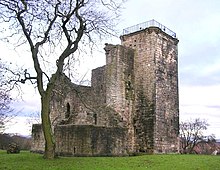Crookston Castle
Crookston Castle is a ruined castle in the south-west Pollok district of the Scottish city of Glasgow . The ruin is about eight kilometers southwest of the city center and five kilometers east of Paisley above Levern Water , just before its confluence with White Cart Water .
history
Crookston Castle is surrounded by an annular defensive moat that was dug in the 12th century when Sir Robert de Croc , who was also named after Crookston, built a castle out of wood and earth. The remains of a chapel donated by De Croc in 1180 were also discovered . Evidence of the existence of an even earlier fortification was also found in the same place. The Crookston Estate was bought by Sir Alan Stewart in 1330 and then passed to Sir John Stewart of Darnley in 1361 . The Stewarts of Darnley replaced the early castle around 1400 with the stone building that has been preserved to this day.
In 1489 the Stewart Earl of Lennox rebelled against King James IV. King James responded by bringing the Mons Meg cannon from Edinburgh and bombarding the castle. He practically destroyed their entire west side, which ensured a quick handover. In 1544 the castle was besieged and taken by James Hamilton, 2nd Earl of Arran , and Cardinal David Beaton , while the then Earl of Lennox defended Glasgow Castle . At that time, Crookston Castle was considered the headquarters of the Earls of Lennox .
The most famous of the Darnley Stewarts was Henry Stuart, Lord Darnley , the second husband of Mary Stuart . Presumably the couple got engaged under a yew tree at Crookston Castle . The yew tree was felled in 1816 and a model of Crookston Castle, now on display in Pollock House , was carved from its wood. In 1572 Crookston Castle was loaned to another Stewart, Charles Stuart, 1st Earl of Lennox .
In 1703 the Duke of Lennox sold the castle to the Duke of Montrose and it stayed in the family until 1757 when William Graham, 2nd Duke of Montrose , sold it to Maxwells of Pollok. After the castle had been uninhabited for many years, the Maxwells had it partially restored in 1847 on the occasion of Queen Victoria's visit to Glasgow. In 1931, Crookston Castle became the first property to be acquired by the National Trust for Scotland . Sir John Maxwell, 10th Baronet , founding member of the Trust and its first Vice President, contributed the castle. Today Crookston Castle is a Scheduled Monument . Historic Scotland is responsible for the maintenance.
architecture
Crookston Castle sits on top of a natural hill and is highlighted by the early moat that can still be seen today. On the north side a steep slope leads down to Levern Water. The castle has a rectangular main block reinforced by a tower at each corner. It had an irregular, X-shaped floor plan, an unusual arrangement that can be found elsewhere at Hermitage Castle . Only the north-east tower is preserved in full, as is the foundation of the south-east tower. The two western towers were destroyed in the 15th century and never rebuilt. Repair work in the 19th century even covered up all traces of these towers. The main block of the castle covers an area of about 19 meters by 12 meters; the walls are up to 3.7 meters thick. The northeast tower has a footprint of about 6 meters × 6 meters.
The entrance to the castle is on the north side, adjoining the northeast tower. It is protected by a portcullis and two doors. A straight walled staircase leads up to the right, while straight ahead to the ground floor with barrel vaults , window slots and a fountain. The knight's hall was on the first floor and also had a vaulted ceiling that was up to 8.3 meters high. A straight staircase with a landing in the southeast corner provided access to another floor above the knight's hall and to the upper rooms in the eastern towers. The towers had one room per floor. On the ground floor of the northeast tower was a prison that could only be reached from above. The four floors of the tower can be reached via modern iron ladders. The roof offers an impressive view. The roof of the northeast tower, including the consoles, was also rebuilt in the 19th century .
In the literature
The poets Robert Burns , William Motherwell and Robert Tannahill mentioned the castle in their works, whereas Walter Scott stated in his novella The Abbot of 1820 that Mary Queen of Scots watched the Battle of Langside from a place below the yew tree, although the terrain made this impossible power.
Individual references and comments
- ^ National Monuments Record of Scotland . Site Reference NS56SW.
- ^ Martin Coventry: The Castles of Scotland . 3. Edition. Goblinshead, 2001. p. 160.
- ^ Gordon Mason: The Castles of Glasgow and the Clyde . Goblinshead, 2000. p. 101.
- ^ Thomas Thomson (editor): A diurnal of remarkable occurrents that have passed within Scotland since the death of king James IV till 1575 . Bannatyne Club, 1833. p. 31.
- ↑ Also Wemyss Castle is mentioned as a place for the betrothal.
- ↑ Entry on Crookston Castle in Canmore, the database of Historic Environment Scotland (English)
- ^ A b Gordon Mason: The Castles of Glasgow and the Clyde . Goblinshead, 2000. p. 102.
- ^ A b Maurice Lindsay: The Castles of Scotland . Constable, 1986. p. 177.
- ↑ All dimensions are from Salter.
- ^ Mike Salter: The Castles of South West Scotland . Folly Publications, 1993. p. 134.
- ^ Maurice Lindsay: The Castles of Scotland . Constable, 1986. p. 178.
Web links
Coordinates: 55 ° 50 ′ 6 ″ N , 4 ° 7 ′ 21 ″ W.
